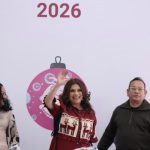August 28, 2022, 4:00 AM
August 28, 2022, 4:00 AM
Most of the accommodations located in red zones of the main cities of the country became fronts for the sexual trade of adolescent and young women. The victims suffer their sorrows between four walls meters away from the urban chaos. They were captured by different methods – most of them by employment agencies and social networks – and behind them are seven “heads” that are part of the human trafficking and smuggling networks.
Laura (not her real name) was able to escape from a trafficking and smuggling network. She was locked up in a lodging in the October 12 area of the city of El Alto for six months. She managed to get out of it due to an oversight of her captors, since one of them left her cell phone in her bedroom. Laura, who now works against the crime of human trafficking and smuggling, recounts that there were nights that she slept in the lodging, but most of them were taken to different addresses in that city.
She was recruited by an employment agency. She was looking for work and they offered to take her to the city of Santa Cruz de la Sierra to work in a restaurant. They took her from Cochabamba to El Alto and told her that they were going to pick up other contractors from La Paz. There she made him spend the night in an accommodation. For many days she could not get out of it. They took her cell phone and her documents. She threatened to harm her family if she did not accept being a prostitute. It was May 2021 and her dream of earning money after a harsh pandemic had turned into a nightmare that was difficult to escape.
But he did. In one of the homes where he slept – which he says were extremely poor – he managed to obtain a cell phone that one of his guardians had neglected. She called her mother and the Police managed to rescue her in an operation that included 20 lodgings in the city of El Alto.
“It is unfortunate what is happening. One can have some confidence, but given the situation, unfortunately, these centers are becoming nests for antisocials, undocumented foreigners, and girls who are forced into the sex trade,” reproached Lieutenant Boris Gutiérrez, head of the Human Trafficking and Trafficking Division of the Special Force to Fight Crime (Felcc) of El Alto.
The Training and Service Center for the Integration of Women (Cecasem) collects testimonies from various victims of human trafficking and smuggling and collaborates with different institutions to counteract this crime.
“It is unfortunate that these types of events occur in our country. For this reason, it is very important that all public and private institutions, neighborhood associations, educational centers, fathers and mothers work in a co-responsible manner in prevention to prevent the right to life from being violated”, lamented the director of Cecasem, Patricia Bustamante.
For the Bolivian Police, the scheme of the trafficking networks is growing with more participants. They are the “criminal minds” that rise in a single criminal organization and that each one has a mission in this crime.
According to a report accessed by EL DEBER, now seven people operate behind a single mafia dedicated to human trafficking and smuggling. On the front lines are the “hookers” or the “handers”, who are the people who discover and approach the victims. Then there are the “intermediaries” or “negotiators”, who are the liaison agents between the deliverers and the houses of prostitution or places of exploitation.
In the third line are the “commission agents”, who are the people who work in job placement offices, employment agencies, who publish job advertisements in newspapers and also -now with more participation- those who recruit through social networks.
Then “counterfeiters” enter the business, providing false documentation to victims, usually to move them to other countries. In the fifth line of a network are the “indicators”, who are those who are in charge of monitoring the movements of the Police to encourage any type of operation or raid. These individuals have contacts in the police force.
Then there are the “sex traders”, who are the owners of prostitution houses or brothels, most of which operate illegally. At this point there are also “labor merchants”, who are the ones who take the victims to do forced labor with little or no pay.
Finally, the network is run by a “pimp”, people who live off the money from the proceeds of the sex trade made by the victims. Their way of working consists of coercion, fear and physical punishment if their demands are not met.
A few days ago a 14-year-old girl managed to file a complaint after being missing. The Police gave her whereabouts in a hotel in the Santa Cruz capital where she was being prostituted. The investigation revealed that she would not be the only victim and that this fact is part of a human trafficking and smuggling network that operates in Santa Cruz from social networks. mainly from the Facebook page.
“The networks of traffickers, before formulating linking strategies or recruitment methods, carry out a previous study-investigation of the frequent places where there is a greater influx of people, such as girls, adolescents and young people, mainly women, due to the situation of risk and their vulnerability in these crimes. Now, they also do this recruitment work through social networks, offering jobs abroad, mainly to people with limited resources”, says the Cecasem report.
Unlike the same period in 2021, in the first half of this administration, cases of human trafficking and smuggling increased by 23%. Until July 28, 2022, the State Attorney General’s Office handled 1,081 investigations related to human trafficking. Different institutions held fairs on the subject, but the victims regret that the authorities only remember this crime on the day that this international struggle is commemorated.
In the last case in Santa Cruz, in addition to the 14-year-old girl, another 15-year-old girl was rescued from the same accommodation. The Felcc investigates if these victims were given drugs so that they could be prostituted. This hotel did not have an operating license, in addition to complaints for accommodating minors without the company’s procedure or authorization from parents or guardians.
“Two people were arrested for the crime of aggravated pimping. He is a man who was looking for clients to prostitute minors and his partner, a woman who is co-author of the criminal act. One of the minors disappeared on August 20 from her home and a day later the police personnel became aware of the fact and the rescue operation of the two minors was carried out. We recommend parents to control their sons and daughters how they use social networks, tell them not to accept messages from strangers”, recommended the director of the Felcc Santa Cruz, Colonel Julio Cossío Camacho.
The Association for the Support of Family Victims of Human Trafficking and Related Crimes (Asafavittp) reports that only two families of the associates were able to recover their daughters who were victims of the trafficker networks.


















